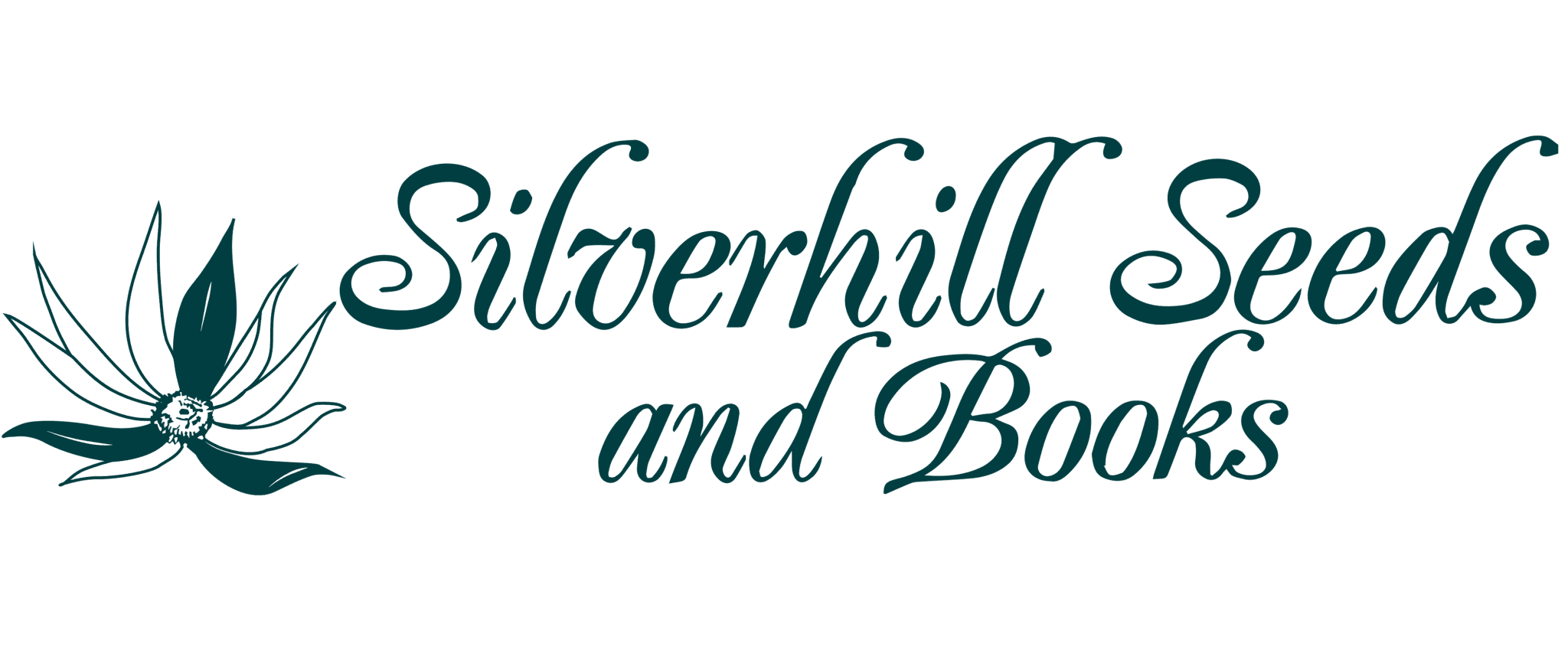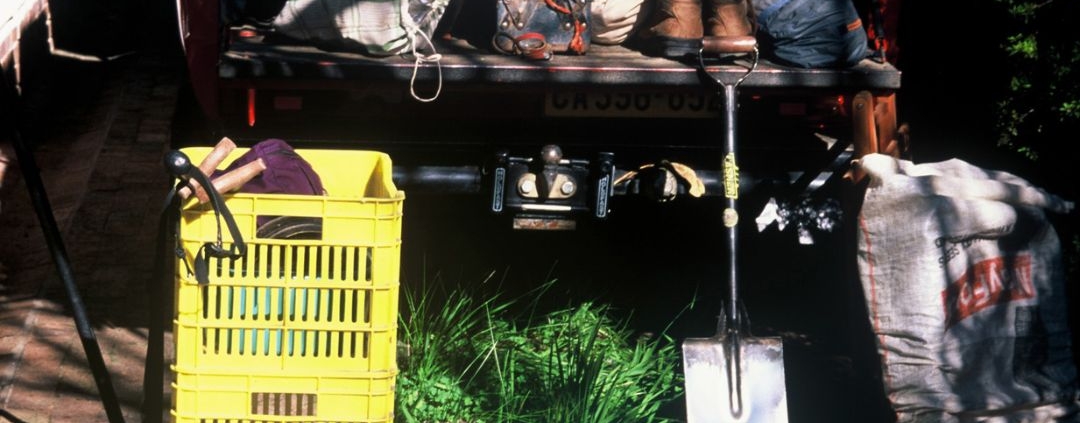From The Archives – Seed Collecting in Africa
By Rod and Rachel Saunders
“What a wonderful job and what a wonderful life” is the reaction of most people when we tell them what we do. And yes, sometimes it is, but, like all jobs, sometimes it isn’t! Our job takes us all over Southern Africa from the southern most tip near Cape Town, to the north of Zambia, about 4 000km away; from the Atlantic Ocean in the west of Namibia to the Indian Ocean in the east. We see deserts, grasslands and lush forests; rain, snow and boiling heat; mountains and rolling plains. We also see environmental destruction on a massive scale, varying from pine and eucalyptus plantations to urban sprawl, golf estates, mining operations and agriculture such as wheatlands and vineyards.
To put it in a nutshell, what our job involves is travelling through the country collecting seeds from as many species as possible on the way. We travel in a 4 wheel drive pick-up Landcruiser, and we walk as much as we can. We have a small fridge in our car to keep the beers cold, and at night we sleep in a roof-top tent which keeps us away from the dust and dirt and animals on the ground. We collect seeds in friend’s gardens, on road verges, on farms and in forests, on the sea-shore and high in the mountains. And obviously, during our travels, we have many experiences, some wonderful, and some not so wonderful!
Firstly, the weather. Living in a tent, walking in the mountains and collecting seeds, we are 100% exposed to whatever weather conditions the gods throw at us. We have had several not to be recommended experiences in the mountains while walking, most of them involving rain and snow. Once in the Drakensberg we spent the night in a cave high in the mountains close to the Lesotho border. In the morning we set off in beautiful clear weather, sun shining warmly down and a gentle breeze. As we walked into Lesotho over the collapsed border fence, for some reason I tied a small piece of plastic to the fence above the cave. We walked all morning collecting seeds and had lunch near a clear and lovely stream. Early in the afternoon we noticed some small clouds, which rapidly grew into bigger clouds and half an hour later we were enveloped in thick mist. By then we had walked several kilometers, and we suddenly realized that we had to find one small cave in a large white landscape! We kept our heads, turned in the direction that we thought we should be going and tried to walk in as straight a line as possible towards the escarpment. After 45 minutes or so, we hit the border fence, so our straight line was pretty good! Keeping the fence on our left, we walked up hills and down valleys until we finally saw our little piece of plastic, waving in the breeze! With great relief we climbed over the fence, found the cave and had a hot cup of tea! The next morning we woke up to thick snow on all the surrounding high peaks – a beautiful sight.
On another occasion we were walking in the Chimanimani Mountains in eastern Zimbabwe in winter, the dry season. During the night, to our surprise, we heard the sound of rain on our tent. By morning, our tent was floating and our flat plain had turned into a shallow lake! We packed up in the rain and decided to head for our car which was parked at the base of the mountain, a day’s walk away. We were unfortunately on the wrong side of a major river which drains the mountains, and we soon found that we couldn’t cross the river which was now in flood. Our only option was to stay on our side of the river and to walk to a large and comfortable cave that we knew of 2 or 3 hours away. So off we went, but our memories of the route were not too accurate and we had forgotten that we had to cross 3 side rivers, which of course were also in flood! With our packs on our heads and clutching onto half submerged trees, we managed to get across them and by lunch time we reached the cave. By then our clothes were soaked but our warm sleeping bags were dry, so we had lunch huddled in our bags at the back of the cave, watching the rain pouring down. Later in the afternoon the rain stopped and a rather watery sun emerged from the clouds. “By morning the river should be down and we will be able to cross easily” said Rod, so we spent the afternoon collecting wet seed into paper bags. However, as the sun set, the clouds rolled back in and as we ate our rather meager supper, down poured the rain again! By morning we felt desperate – our food was running out, the rain was still bucketing down, and a brief excursion to our little nearby stream showed us a raging torrent! Clearly the main river would still be uncrossable. Finally by lunch time the rain stopped and in the late afternoon we decided to pack up and walk as far as we could on our side of the river, and then try to cross. So off we went. Shortly before darkness fell we found a spot where the river narrowed with a large rock on our side. Rod threw his rucksack across the river and then leapt after it, thankfully getting across. After throwing my pack towards Rod, I jumped and was hauled across by my ski pole walking stick, landing with one foot in the river. I burst into tears with relief, and after sorting ourselves out, we walked until we found a level spot where we put up the tent and ate our last slice of bread for dinner!
Normally however, we curse the heat far more than the cold and rain, and we more often collapse exhausted and hot into cold mountain pools to seek relief. Often while driving through the Karoo or Namaqualand, we look for farm dams or reservoirs, and leap in, sometimes clothes and all to cool off.
Obviously the weather also has a huge effect on the seeds that we are collecting. If it has been too dry, we frequently find no seed at all – the flowers simply fade away, setting no seed. If it is too cold and wet, the same may occur as most pollinators need temperatures of at least 16 C to fly. Cold weather also affects the time seeds take to ripen – most Irid seeds normally ripen in 6 weeks, but cold weather can retard this to as long as 8 weeks. Similarly hot dry weather can shorten ripening to 5 or even 4 weeks. This results in our most frequent lament “green or gone!”. Particularly annoying when one has traveled 1000km to collect some special seed, to find one missed it by a week! If we find slightly green seed, it can often be ripened in jars of water which are precariously arranged in the back of our vehicle, but there is nothing one can do about “gone” seed.
Secondly, the actual process of seed collecting can also be “hazardous”. Like the day we were collecting seed of Rhus pendulina, a large tree frequently used as a street tree in low rainfall towns. We collected the seed into an upturned umbrella which is efficient and very quick, and transferred it into a paper bag. We then went into the local shop to buy some lunch, and drove on our way. About 10km further on, Rod suddenly shrieked “There’s something in my beard. STOP!!” I hurriedly stopped, peered into his beard, and burst out laughing – it was a baby chameleon! It had obviously fallen out of the tree into his beard while we were collecting the Rhus seeds. We wondered how many people in the shop had noticed, but its camouflage was perfect!
Another amusing encounter with chameleons was on a cold winter’s day in Johannesburg. We were collecting Combretum seeds – these seeds hang in clusters and are easy to collect in great handfuls. As I grabbed a bundle of seeds, I felt a cold and almost clammy thing in my hand, and dropped it with a scream. We dug around in the seeds to see what it was and found a tiny chameleon in hibernation in the middle of the seed cluster! Rod make some remark about feeble hysterical women, but a minute or two later he also let out a scream – he had found one too!
Another day was potentially more disastrous. Rod went wandering off while I packed up the lunch, and suddenly he came running back, waving his arms and shouting “Get into the car” – so I did! He opened the door and leapt in, together with a large number of bees, buzzing angrily around his head. He had unfortunately chosen to have a pee on top of a bee nest, in the ground under some grass! They had taken exception to this, and had come out fighting! African bees have a well deserved reputation for being fierce, and fierce they were. Rod drove off rapidly and opened all the windows trying to shoo the bees out. He got stung about 10 times, but I am allergic to bee stings, so my efforts at bee removal were frantic! We stopped a short distance down the road to clear the car of the last stragglers and I realized that I had a bee under my shirt. Without thinking I desperately tore my shirt off, to the amazement of all the motorists on the busy highway, but I didn’t get stung!
Travelling as we do in some very out-of-the-way places, we often encounter wild life of varying sorts. One day in Namibia we were lucky to see a herd of gemsbok, 2 jackals and a pair of honey badgers early one morning in the middle of the Namib Desert. In the Drakensberg we were woken up one night by noises around our tent, and we realized that something was eating our ripening seeds propped up in their jars of water. We leapt up shouting and whatever it was ran off. We went back to sleep muttering about “damn donkeys, the scourge of Africa”. Next morning we peered out of the tent to find a herd of Eland, looking longingly at our Agapanthus and Galtonia seed spikes which were now safely out of reach. Not donkeys at all!
And of course we quite often see snakes – sometimes pythons or mambas that reach right across the road, but more often fat lazy puff adders, very poisonous snakes which often bite when walked on. They love the warmth of the road, and because most people run over them deliberately if they see them, we always stop to move them from danger. We carry a long handled pole pruner with us, and it is very useful for prodding snakes out of the road!
Probably our funniest encounter with wild life was the day we met an ostrich! We were walking in a nature reserve in Swaziland and suddenly noticed that we were being followed by an ostrich. It was right behind us, and each time we stopped to look at a plant, it stopped too, and scratched around in the soil, looking for insects to eat. We walked about 6 or 7 km, with our ostrich accompanying us all the way. We came round a corner and almost fell over a litter of warthog babies which seemed to have lost their mum. They ran towards us, squealing madly, and we nearly had a fit – warthog mothers are extremely fierce and charge without hesitating, and we didn’t really want to meet mum! We turned round and fled, and our ostrich fled with us – she obviously didn’t want to meet mum either! All 3 of us walked back to the camp site for supper – a barbecue for us and bread for the ostrich!
We do quite often have problems with donkeys, cattle and sheep, particularly with bulb seeds. Normally each year we try to visit an area in flower, and then we go back 5 to 7 weeks later for seed. And frequently during our absence, the farmer puts his stock into the field, and that’s the end of our seeds. Particularly Gladiolus spikes and almost always, it is a rare Gladiolus that grows a long way from home!
Another strange problem we have had was with mice. Quite a few of the seeds that we collect are expelled from their seed capsules by an explosive or extrusion mechanism. Explosive capsules include the Rutaceae such as Agathosmas and Coleonemas, and those that are pushed out or simply fall out include Proteaceae such as Paranomus and Serruria, and Irids such as Nivenias. The simplest method of collecting these seeds is to either envelop the entire plant in a net made of net-curtain material, or to cover the flower head with a stocking tied around the base. One hot summer’s day we spent a couple of hours at a population of Serruria tying stockings onto old flower heads with string. About a month later we returned to the site to see if the seeds had been released yet, and found that they had. So we began removing the stockings, untying them carefully over a paper bag to catch any seeds that fell out. As Rod clutched a stocking prior to untying the string, it wriggled! He jumped backwards in fright and then burst out laughing as a mouse peered out of a hole, whiskers bristling! Protea seeds are oily and very nutritious, and a population of lucky mice had discovered our bags full of seeds. Needless to say, we got no Serruria seeds that year!
However, despite all the hazards and trials and tribulations, we do have some good days too. Those early spring days in the Cape mountains when the weather is warm but not too hot, the ground is wet from the previous day’s rain and the flowers are magnificent. Or summer days in the rolling foothills of the Drakensberg mountains in undisturbed high altitude grasslands. This is the habitat for sheets of Kniphofias, hundreds of species of ground orchids, Agapanthus and Eucomis in the gullies and Lammergeier eagles soaring above. Or if seed collecting becomes too much on wet rainy days or on hot summer days, we can always go wine tasting at one of the wineries in the SW Cape, or head for the beach! Then we agree with all those people who think we have a wonderful life!
Having collected all our seeds in various parts of South Africa, the cleaning and processing has to begin. In fact, it begins even before we get home.
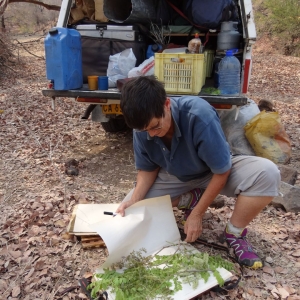
The first processing begins the same evening as the collection was made. All the seed packets are fully labelled – a date of collection, a name of some sort (often a tentative guess!), and locality details. Sometimes there may also be a reference to a digital photograph number on the packet, or when we really couldn’t identify the species, a reference to a herbarium sheet that we made of the plant. In the car we carry as many books as we can – usually 8 or 10 selected according to our itinerary and the time of year. In July (mid-winter) we collect mainly tree seeds in the summer rainfall areas of the country, and there are virtually no bulbous plants in flower, so we will take tree and shrub books and no bulb books. In August and September we need books on Namaqualand annuals, bulbs, Ericas, shrubs and trees, and more. The books most frequently used are those with good keys and preferably illustrations of some sort such as Field Guides and specialised books on genera such as Gladiolus, Ixia, Kniphofia etc. However we also often use books such as “Cape Plants” by Peter Goldblatt and John Manning which is simply a list of all the species in the Cape Floral Kingdom, with basic keys and basic descriptions. Whichever books we have with us, we can be sure that there is at least one that would have been more useful which is sitting on the shelf at home!
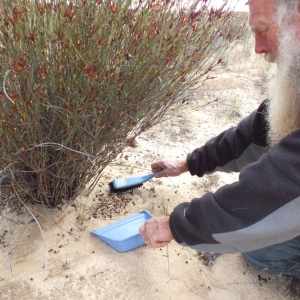
On our travels we carry a set of laboratory sieves in one of the crates in the car, and if the seed is dry, we sieve it to get rid of unwanted bulk, and also to get rid of some of the insects which are lurking in the seed capsules. Kniphofias and Aloes are particularly bad in this respect – they are obviously very nutritious and the shape of the seed capsules is just right for insects of all sorts to hide in. The seeds are then dusted with a relatively mild insecticide to prevent further insect damage.
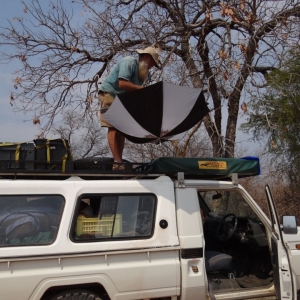
Tree seed poses particular problems of bulk as it often has pods or other bulky capsules which need to be crushed or split to release the seeds. Sometimes all that is required to open a pod, especially Bauhinias, is warm air circulating around them. We place the un-open pods in sacks on the roof of the car and leave them there for a day or two as we travel. As the pods split they often go off with a bang like a pistol shot which is sometimes loud enough to wake us at night! Others, such as Acacia pods, can be split by hand, and this is done on the journey by whoever is not driving. However, some Acacia pods are indehiscent and the seed is only released when the pod is eaten by game or livestock. The pods have a sweetish smell and are normally brittle and hard, and they are eagerly sought out by game. To reduce the bulk of these, we place the pods in sacks and jump up and down on them, thereby crushing the capsules and releasing the seed. The resulting debris is sieved and the seeds retained. In this way, 30 – 40kg of raw material is reduced to a few hundred grams of clean seed.
Fleshy seed is usually cleaned the same day if water is available. If not, then it is packed into a leak proof container on the roof of the car where it cannot contaminate other dry seed. We carry a bucket and a large basin with us, so that seeds can be cleaned in rivers when available, or under taps in camp sites.
On the whole, bulbous plant seed is fairly simple – it is not normally too bulky, so requires a minimal amount of pre-cleaning. It is simply labelled and treated with insecticide, and put away.
And where does all this seed fit? When we pack our car, most things are packed into stackable plastic crates – food, rucksacks, boots, books etc. There are also many empty crates, both on the roof of the car and in the back. The seeds in their brown paper packets, are sealed with sticky tape, and are packed into these crates. The crates have holes in the sides and bottoms, so they allow good air circulation. This is important as there is almost always residual moisture in the seeds, and we certainly don’t want to arrive home with moist and mouldy seeds.
On arriving home, the seed is unpacked and systematically sorted. First to be cleaned is recalcitrant and perishable seed, so this is all packed into 1 crate. Next in line is all the fleshy seed which must be cleaned before it ferments and gets too disagreeable! Then the seeds with the most insect pests – Irids and other bulbous plant seeds, Aloes, Acacias and other legumes. The harder more “insect resistant” seeds are left until the end, as are the succulents such as mesems, and the host of unidentified nightmares!
The term “recalcitrant” is used to describe a type of seed that does not conform to normality. These seeds have no dormancy mechanism and regardless of conditions, they will germinate immediately on being separated from the parent plant. Most of the South African amaryllids (except Cyrtanthus) fall into this category (including Nerines, Brunsvigias, Crinums etc). If we don’t have a customer for these seeds immediately, we store them at 4°C to slow their germination, often in damp vermiculite to prevent them from drying out. If we are on a long trip, we usually send these seeds home by post and they are cleaned by our staff at work.
Fleshy seeds are steeped in water overnight, and the flesh is then pulverized so that it floats away with the water while the heavier seeds sink to the bottom of the bucket. Often several changes of water are required before the flesh is finally removed. Some seeds such as those of Sclerocarya birrea (marula, a large tree with edible fruit) have flesh which adheres firmly to the seed and it cannot be removed easily. Either these seeds are left in a plastic bag in the sun for several days until the flesh begins to ferment and soften, or they are cleaned in a cement mixer. Several kilograms of seed are placed in the cement mixer together with a quantity of stone chips, and this is rotated for several hours until all the flesh has been ground off. The seed is then washed and dried.
Legume seed is usually easy to clean, but because it is so palatable to insects, it needs to be processed quickly before it is all eaten. For the same reason, bulbous plant seeds also need to be processed quickly. These all follow the same routine – dry the capsules well, break them up and sieve out the seed. All the small bits and pieces which go through the sieve with the seeds are winnowed off by blowing. Rod, who cleans most of the seed, wanders round the garden while doing this, resulting in all sorts of strange plants coming up in odd spots! Although the seeds are heavier than the chaff, invariably some seeds blow off with the rubbish. Gladiolus seeds differ a bit in that they are firmly attached to the capsules. They are cleaned by drying them thoroughly so that the capsules open fully and expose the seeds, and then shaking the capsules in a bucket to release the seeds.
The cleaned seeds are usually put into new paper bags or packets, labelled carefully, treated with an insecticide if necessary, and are then fumigated with Phostoxin for 5 days to kill any insects that hatch after cleaning and any larvae still lurking amongst the seeds.
After 5 days, the seeds are moved to our seed room and are catalogued, all collecting information is recorded, and they are put away. The seed room itself is regularly fumigated with a pyrethroid to deal with any insects that have come in from outside. In the past we have had some really spectacular outbreaks of seed parasites, invariably in the bulb and Aloe seeds. It is a seed merchant’s worst nightmare finding the seed room full of moths and beetles, and knowing that they have hatched somewhere amongst all the seed packets, or opening a packet of precious seed that took hours to collect, and finding that the seeds are full of holes!
If a plant has not been identified in the field, we will try to find a name at home where we have an extensive library and can key it out using one of the taxonomic monographs. If we still can’t get a name, we will take it up to the Compton Herbarium at Kirstenbosch and enlist the aid of a friendly botanist. We are surprised how often we come up with a plant that is undescribed – sometimes it has been collected previously but still has no name, and sometimes it has never been collected before. So far the list includes an Ixia, a Romulea, 2 Babianas and a Hesperantha that had not been seen for over 100 years. Often these discoveries occur because we are in the right place at the right time, and the right time is often an unusual time of year when botanists are not often in the field. The Romulea was discovered because we could not tell the difference between 2 yellow flowered species growing side by side. The only way we could distinguish between them was by the corm shape, and on digging up a corm of the new species, we realised that we had never seen anything like it before. The new species was named Romulea discifera, for the strange corm. “There is always something new out of Africa”!!
Do we ever make mistakes? No never! Well, hardly ever! Well, sometimes! Mistakes can occur because of the lack of flowers when one collects the seeds, so we are not always one hundred percent sure that the species we saw in flower is the same as the one whose seed we are collecting. Or if we are dealing with a large and complex genus, we sometimes simply make a mistake using the key. But sometimes the mistakes come about due to bad labelling! If Rod has been cleaning many Gladiolus species, and then changes to Romuleas, we will sometimes land up with strange species such as Gladiolus amoena, or Romulea dalenii – luckily these mistakes are usually picked up and rectified by the person putting the seed away, or Rachel when she enters the details on the computer.
And finally, how are all the species recorded? All the species that we collect are entered onto a database (Microsoft Access), with the family, genus and species, a description of the plant, and whether it is a bulbous plant, a succulent or a tree. If the seeds were purchased from someone, the price paid and the source is also included. This database is linked to a collecting list which has details on where we collected each species. In the past before we had a GPS, these collecting localities were quite complex – “15km past the T junction on the P1254 road between X and Y, under the tree on the left hand side”! The use of a GPS has obviously revolutionized this, and our collecting details are now far more boring – a plain “GPS 125”! We are also attempting to get a photograph of as many species as possible, and this is also entered onto the database. Digital photography is wonderful, but it has created a huge amount of work – on returning home all the images are downloaded, and then the identifying and labelling begins. We are all guilty of the same problem I am sure – because it is so cheap and simple to take multiple pictures of the same plant, we sometimes have 10 or 20 images of one species to sort through, and trying to decide which image is the best sometimes takes hours! The pictures are linked to the database, so if we have a species in stock and it reflects on the website, then there is a picture of it. As our catalogue often has 2000 species listed on it, we still have many photographs to take.
All in all, seed collecting is an extremely laborious task, but it affords us a good livelihood and a wonderful lifestyle.
